Strategic Development Tools: Usage, Practical Examples and Analysis
VerifiedAdded on 2023/06/12
|7
|1689
|487
Essay
AI Summary
This essay provides an overview of strategy development tools used in business management, emphasizing their importance in achieving organizational goals. It discusses SWOT analysis, highlighting the assessment of strengths, weaknesses, opportunities, and threats, and how managers leverage these factors for strategic advantage. The essay also examines PESTEL analysis, focusing on political, economic, social, and technological factors influencing decision-making. Furthermore, it explores the Resource-Based View (RBV), which emphasizes utilizing internal resources for competitive advantage, citing Apple Inc.'s success against Samsung as a practical example. The conclusion underscores the crucial role of strategic development in helping companies outperform competitors and achieve long-term objectives, advocating for a critical analysis of these tools for effective strategy formulation. Desklib offers a variety of resources, including solved assignments and past papers, to support students in their academic endeavors.
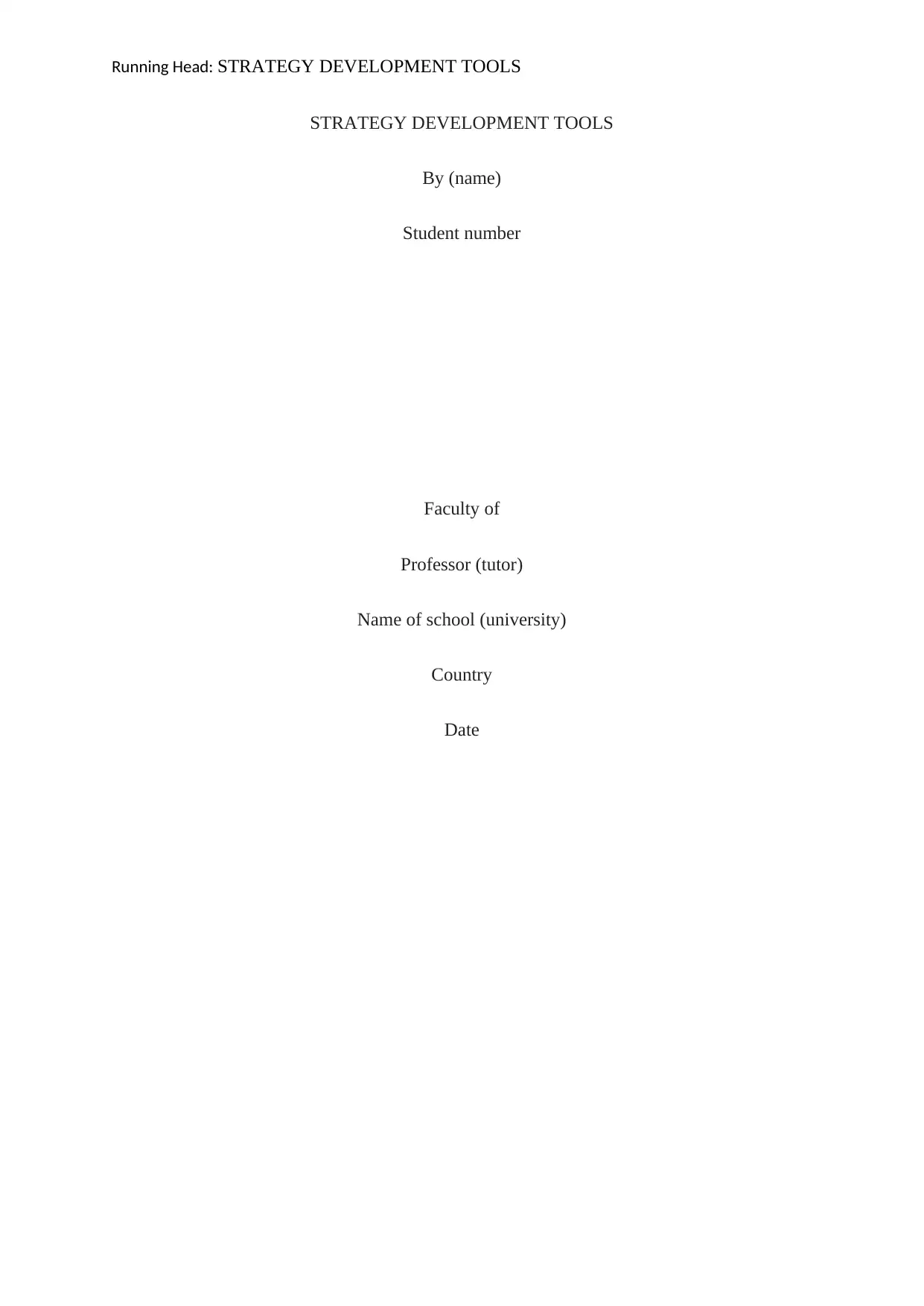
Running Head: STRATEGY DEVELOPMENT TOOLS
STRATEGY DEVELOPMENT TOOLS
By (name)
Student number
Faculty of
Professor (tutor)
Name of school (university)
Country
Date
STRATEGY DEVELOPMENT TOOLS
By (name)
Student number
Faculty of
Professor (tutor)
Name of school (university)
Country
Date
Paraphrase This Document
Need a fresh take? Get an instant paraphrase of this document with our AI Paraphraser
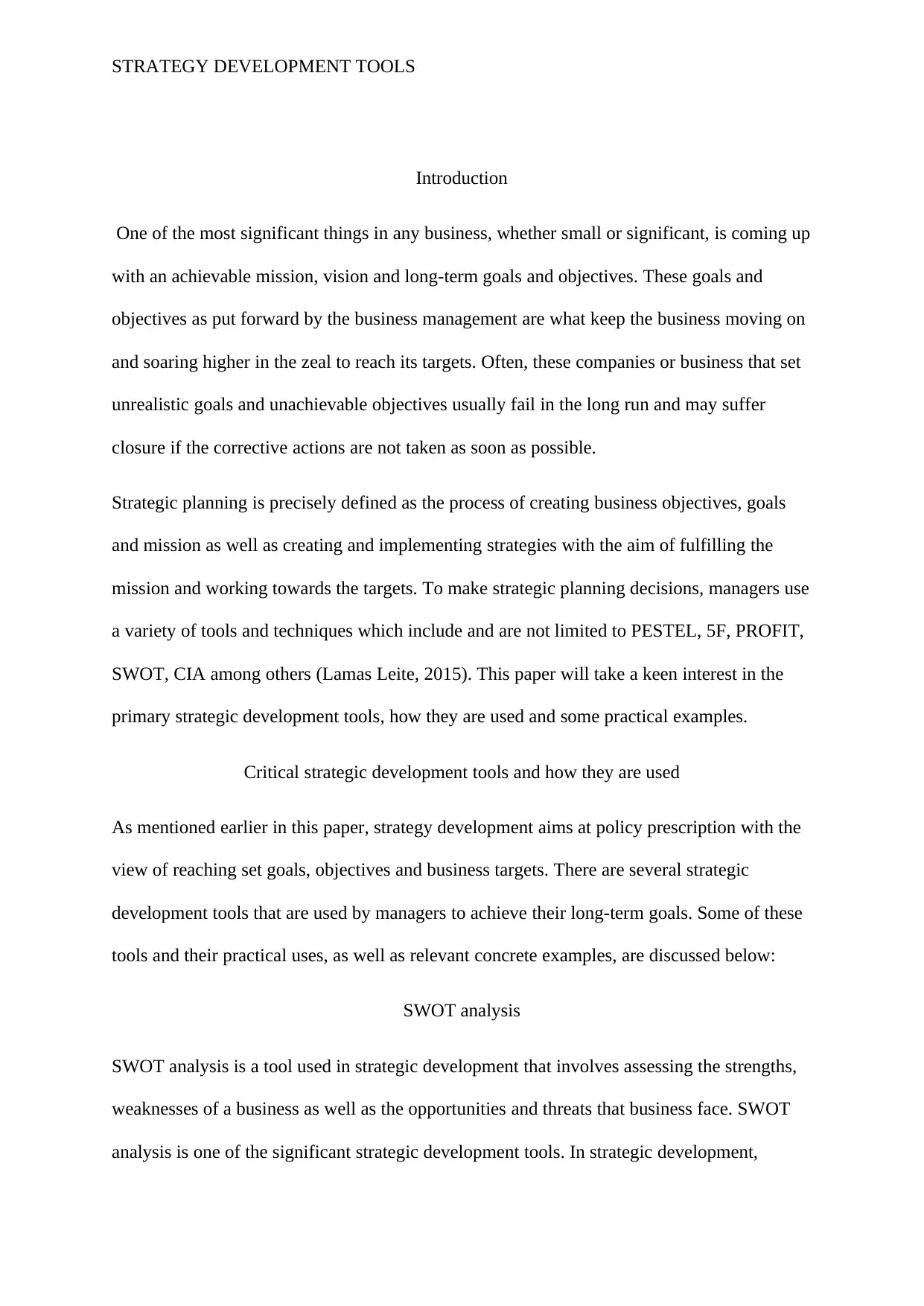
STRATEGY DEVELOPMENT TOOLS
Introduction
One of the most significant things in any business, whether small or significant, is coming up
with an achievable mission, vision and long-term goals and objectives. These goals and
objectives as put forward by the business management are what keep the business moving on
and soaring higher in the zeal to reach its targets. Often, these companies or business that set
unrealistic goals and unachievable objectives usually fail in the long run and may suffer
closure if the corrective actions are not taken as soon as possible.
Strategic planning is precisely defined as the process of creating business objectives, goals
and mission as well as creating and implementing strategies with the aim of fulfilling the
mission and working towards the targets. To make strategic planning decisions, managers use
a variety of tools and techniques which include and are not limited to PESTEL, 5F, PROFIT,
SWOT, CIA among others (Lamas Leite, 2015). This paper will take a keen interest in the
primary strategic development tools, how they are used and some practical examples.
Critical strategic development tools and how they are used
As mentioned earlier in this paper, strategy development aims at policy prescription with the
view of reaching set goals, objectives and business targets. There are several strategic
development tools that are used by managers to achieve their long-term goals. Some of these
tools and their practical uses, as well as relevant concrete examples, are discussed below:
SWOT analysis
SWOT analysis is a tool used in strategic development that involves assessing the strengths,
weaknesses of a business as well as the opportunities and threats that business face. SWOT
analysis is one of the significant strategic development tools. In strategic development,
Introduction
One of the most significant things in any business, whether small or significant, is coming up
with an achievable mission, vision and long-term goals and objectives. These goals and
objectives as put forward by the business management are what keep the business moving on
and soaring higher in the zeal to reach its targets. Often, these companies or business that set
unrealistic goals and unachievable objectives usually fail in the long run and may suffer
closure if the corrective actions are not taken as soon as possible.
Strategic planning is precisely defined as the process of creating business objectives, goals
and mission as well as creating and implementing strategies with the aim of fulfilling the
mission and working towards the targets. To make strategic planning decisions, managers use
a variety of tools and techniques which include and are not limited to PESTEL, 5F, PROFIT,
SWOT, CIA among others (Lamas Leite, 2015). This paper will take a keen interest in the
primary strategic development tools, how they are used and some practical examples.
Critical strategic development tools and how they are used
As mentioned earlier in this paper, strategy development aims at policy prescription with the
view of reaching set goals, objectives and business targets. There are several strategic
development tools that are used by managers to achieve their long-term goals. Some of these
tools and their practical uses, as well as relevant concrete examples, are discussed below:
SWOT analysis
SWOT analysis is a tool used in strategic development that involves assessing the strengths,
weaknesses of a business as well as the opportunities and threats that business face. SWOT
analysis is one of the significant strategic development tools. In strategic development,
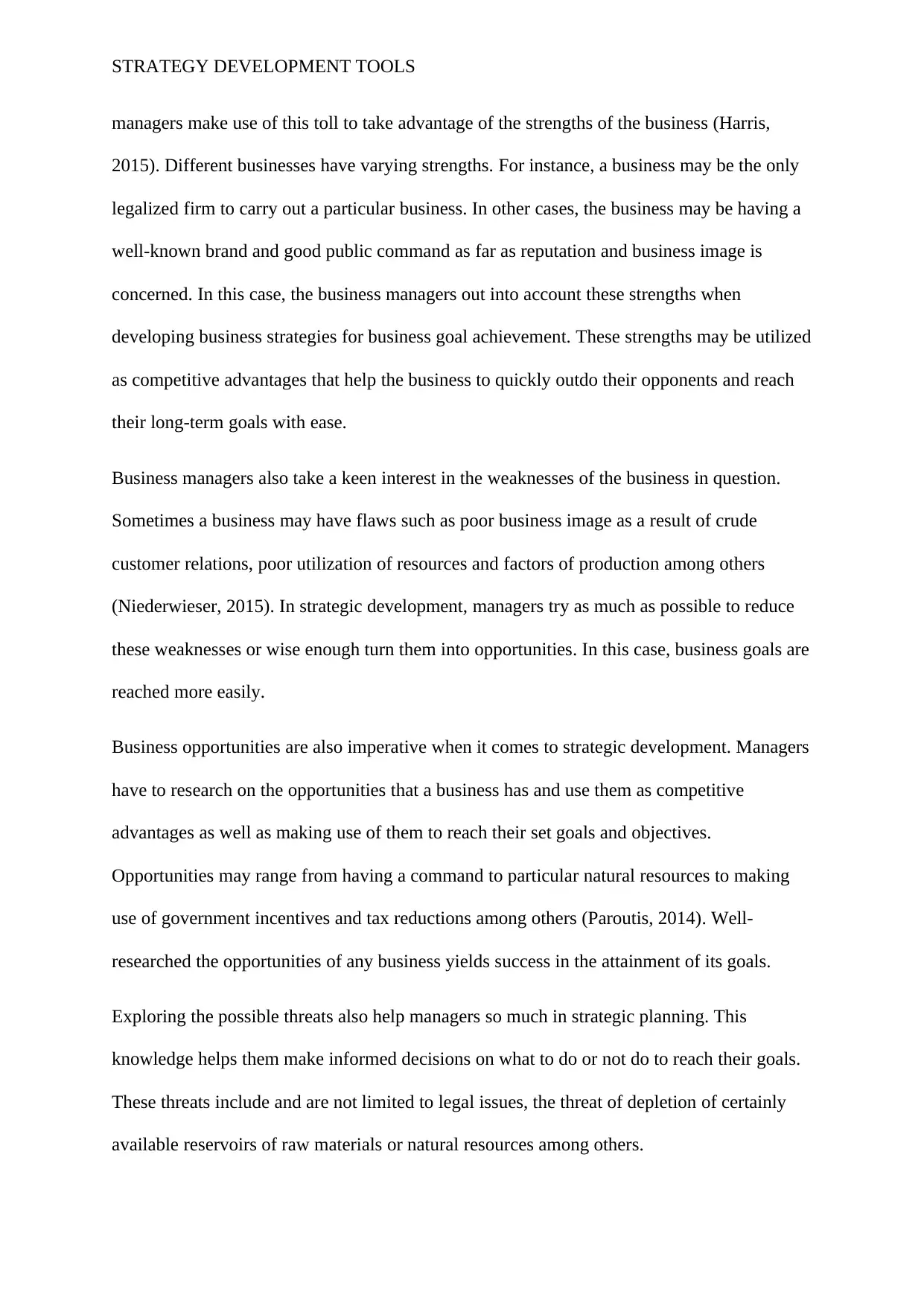
STRATEGY DEVELOPMENT TOOLS
managers make use of this toll to take advantage of the strengths of the business (Harris,
2015). Different businesses have varying strengths. For instance, a business may be the only
legalized firm to carry out a particular business. In other cases, the business may be having a
well-known brand and good public command as far as reputation and business image is
concerned. In this case, the business managers out into account these strengths when
developing business strategies for business goal achievement. These strengths may be utilized
as competitive advantages that help the business to quickly outdo their opponents and reach
their long-term goals with ease.
Business managers also take a keen interest in the weaknesses of the business in question.
Sometimes a business may have flaws such as poor business image as a result of crude
customer relations, poor utilization of resources and factors of production among others
(Niederwieser, 2015). In strategic development, managers try as much as possible to reduce
these weaknesses or wise enough turn them into opportunities. In this case, business goals are
reached more easily.
Business opportunities are also imperative when it comes to strategic development. Managers
have to research on the opportunities that a business has and use them as competitive
advantages as well as making use of them to reach their set goals and objectives.
Opportunities may range from having a command to particular natural resources to making
use of government incentives and tax reductions among others (Paroutis, 2014). Well-
researched the opportunities of any business yields success in the attainment of its goals.
Exploring the possible threats also help managers so much in strategic planning. This
knowledge helps them make informed decisions on what to do or not do to reach their goals.
These threats include and are not limited to legal issues, the threat of depletion of certainly
available reservoirs of raw materials or natural resources among others.
managers make use of this toll to take advantage of the strengths of the business (Harris,
2015). Different businesses have varying strengths. For instance, a business may be the only
legalized firm to carry out a particular business. In other cases, the business may be having a
well-known brand and good public command as far as reputation and business image is
concerned. In this case, the business managers out into account these strengths when
developing business strategies for business goal achievement. These strengths may be utilized
as competitive advantages that help the business to quickly outdo their opponents and reach
their long-term goals with ease.
Business managers also take a keen interest in the weaknesses of the business in question.
Sometimes a business may have flaws such as poor business image as a result of crude
customer relations, poor utilization of resources and factors of production among others
(Niederwieser, 2015). In strategic development, managers try as much as possible to reduce
these weaknesses or wise enough turn them into opportunities. In this case, business goals are
reached more easily.
Business opportunities are also imperative when it comes to strategic development. Managers
have to research on the opportunities that a business has and use them as competitive
advantages as well as making use of them to reach their set goals and objectives.
Opportunities may range from having a command to particular natural resources to making
use of government incentives and tax reductions among others (Paroutis, 2014). Well-
researched the opportunities of any business yields success in the attainment of its goals.
Exploring the possible threats also help managers so much in strategic planning. This
knowledge helps them make informed decisions on what to do or not do to reach their goals.
These threats include and are not limited to legal issues, the threat of depletion of certainly
available reservoirs of raw materials or natural resources among others.
⊘ This is a preview!⊘
Do you want full access?
Subscribe today to unlock all pages.

Trusted by 1+ million students worldwide
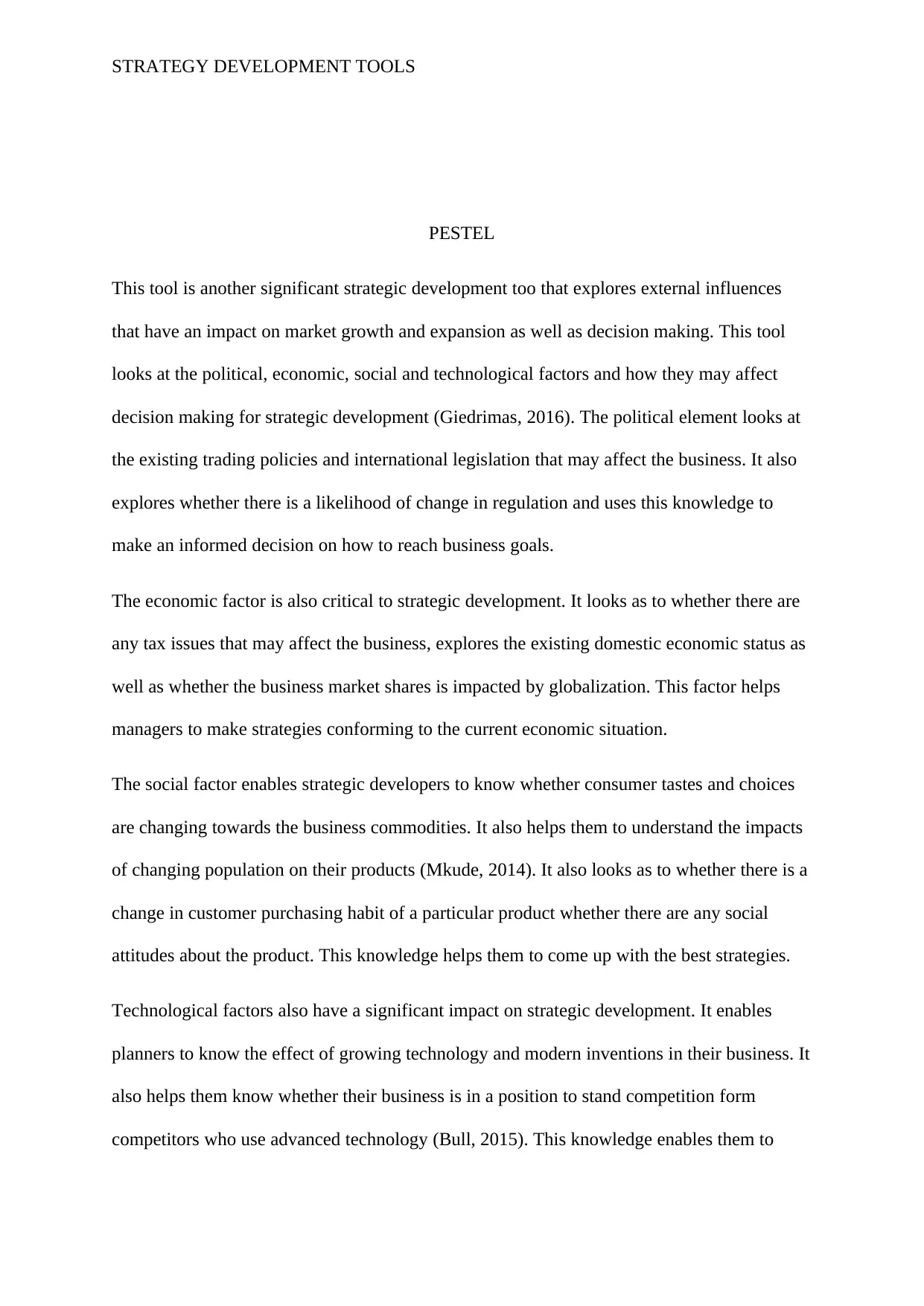
STRATEGY DEVELOPMENT TOOLS
PESTEL
This tool is another significant strategic development too that explores external influences
that have an impact on market growth and expansion as well as decision making. This tool
looks at the political, economic, social and technological factors and how they may affect
decision making for strategic development (Giedrimas, 2016). The political element looks at
the existing trading policies and international legislation that may affect the business. It also
explores whether there is a likelihood of change in regulation and uses this knowledge to
make an informed decision on how to reach business goals.
The economic factor is also critical to strategic development. It looks as to whether there are
any tax issues that may affect the business, explores the existing domestic economic status as
well as whether the business market shares is impacted by globalization. This factor helps
managers to make strategies conforming to the current economic situation.
The social factor enables strategic developers to know whether consumer tastes and choices
are changing towards the business commodities. It also helps them to understand the impacts
of changing population on their products (Mkude, 2014). It also looks as to whether there is a
change in customer purchasing habit of a particular product whether there are any social
attitudes about the product. This knowledge helps them to come up with the best strategies.
Technological factors also have a significant impact on strategic development. It enables
planners to know the effect of growing technology and modern inventions in their business. It
also helps them know whether their business is in a position to stand competition form
competitors who use advanced technology (Bull, 2015). This knowledge enables them to
PESTEL
This tool is another significant strategic development too that explores external influences
that have an impact on market growth and expansion as well as decision making. This tool
looks at the political, economic, social and technological factors and how they may affect
decision making for strategic development (Giedrimas, 2016). The political element looks at
the existing trading policies and international legislation that may affect the business. It also
explores whether there is a likelihood of change in regulation and uses this knowledge to
make an informed decision on how to reach business goals.
The economic factor is also critical to strategic development. It looks as to whether there are
any tax issues that may affect the business, explores the existing domestic economic status as
well as whether the business market shares is impacted by globalization. This factor helps
managers to make strategies conforming to the current economic situation.
The social factor enables strategic developers to know whether consumer tastes and choices
are changing towards the business commodities. It also helps them to understand the impacts
of changing population on their products (Mkude, 2014). It also looks as to whether there is a
change in customer purchasing habit of a particular product whether there are any social
attitudes about the product. This knowledge helps them to come up with the best strategies.
Technological factors also have a significant impact on strategic development. It enables
planners to know the effect of growing technology and modern inventions in their business. It
also helps them know whether their business is in a position to stand competition form
competitors who use advanced technology (Bull, 2015). This knowledge enables them to
Paraphrase This Document
Need a fresh take? Get an instant paraphrase of this document with our AI Paraphraser
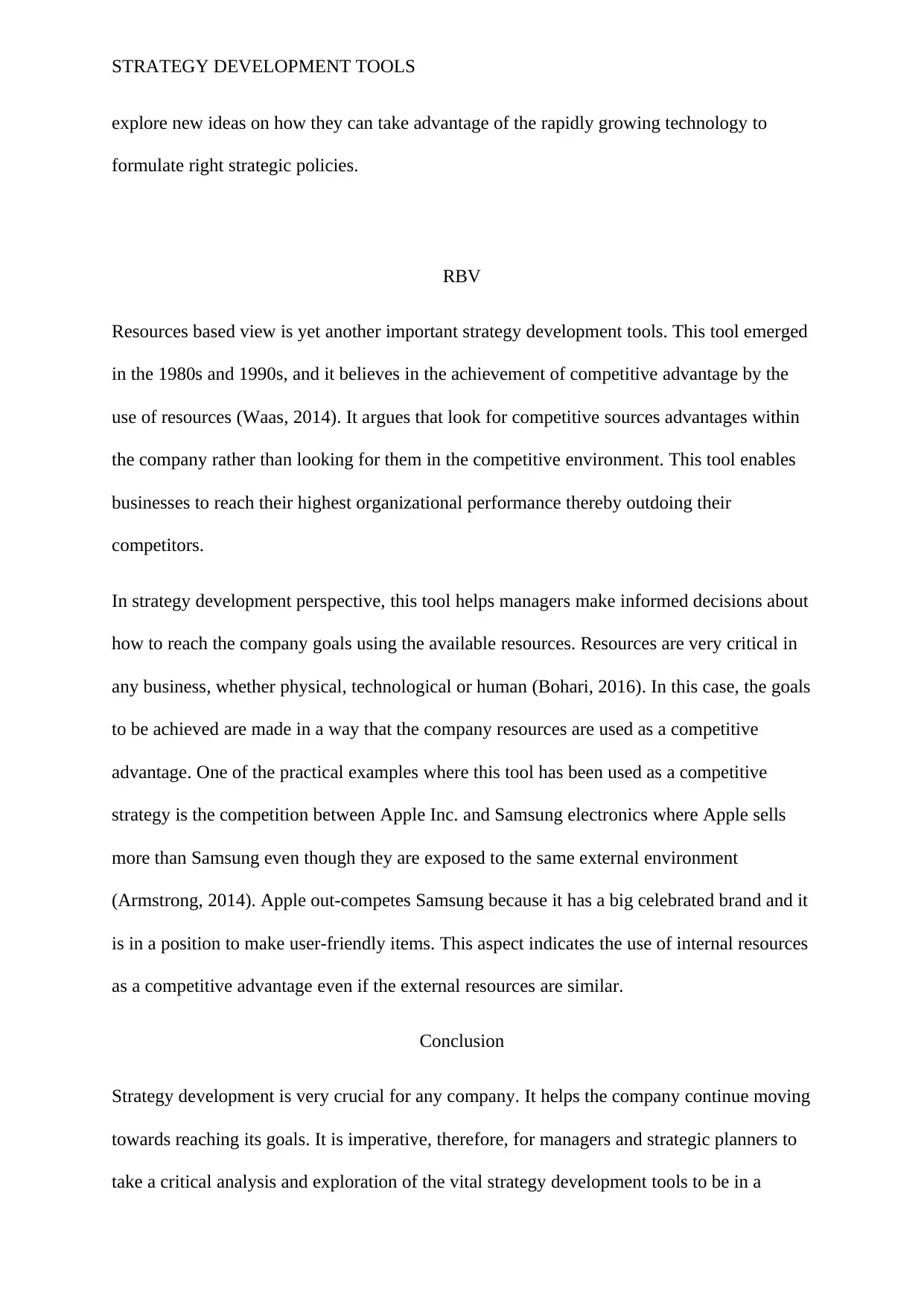
STRATEGY DEVELOPMENT TOOLS
explore new ideas on how they can take advantage of the rapidly growing technology to
formulate right strategic policies.
RBV
Resources based view is yet another important strategy development tools. This tool emerged
in the 1980s and 1990s, and it believes in the achievement of competitive advantage by the
use of resources (Waas, 2014). It argues that look for competitive sources advantages within
the company rather than looking for them in the competitive environment. This tool enables
businesses to reach their highest organizational performance thereby outdoing their
competitors.
In strategy development perspective, this tool helps managers make informed decisions about
how to reach the company goals using the available resources. Resources are very critical in
any business, whether physical, technological or human (Bohari, 2016). In this case, the goals
to be achieved are made in a way that the company resources are used as a competitive
advantage. One of the practical examples where this tool has been used as a competitive
strategy is the competition between Apple Inc. and Samsung electronics where Apple sells
more than Samsung even though they are exposed to the same external environment
(Armstrong, 2014). Apple out-competes Samsung because it has a big celebrated brand and it
is in a position to make user-friendly items. This aspect indicates the use of internal resources
as a competitive advantage even if the external resources are similar.
Conclusion
Strategy development is very crucial for any company. It helps the company continue moving
towards reaching its goals. It is imperative, therefore, for managers and strategic planners to
take a critical analysis and exploration of the vital strategy development tools to be in a
explore new ideas on how they can take advantage of the rapidly growing technology to
formulate right strategic policies.
RBV
Resources based view is yet another important strategy development tools. This tool emerged
in the 1980s and 1990s, and it believes in the achievement of competitive advantage by the
use of resources (Waas, 2014). It argues that look for competitive sources advantages within
the company rather than looking for them in the competitive environment. This tool enables
businesses to reach their highest organizational performance thereby outdoing their
competitors.
In strategy development perspective, this tool helps managers make informed decisions about
how to reach the company goals using the available resources. Resources are very critical in
any business, whether physical, technological or human (Bohari, 2016). In this case, the goals
to be achieved are made in a way that the company resources are used as a competitive
advantage. One of the practical examples where this tool has been used as a competitive
strategy is the competition between Apple Inc. and Samsung electronics where Apple sells
more than Samsung even though they are exposed to the same external environment
(Armstrong, 2014). Apple out-competes Samsung because it has a big celebrated brand and it
is in a position to make user-friendly items. This aspect indicates the use of internal resources
as a competitive advantage even if the external resources are similar.
Conclusion
Strategy development is very crucial for any company. It helps the company continue moving
towards reaching its goals. It is imperative, therefore, for managers and strategic planners to
take a critical analysis and exploration of the vital strategy development tools to be in a
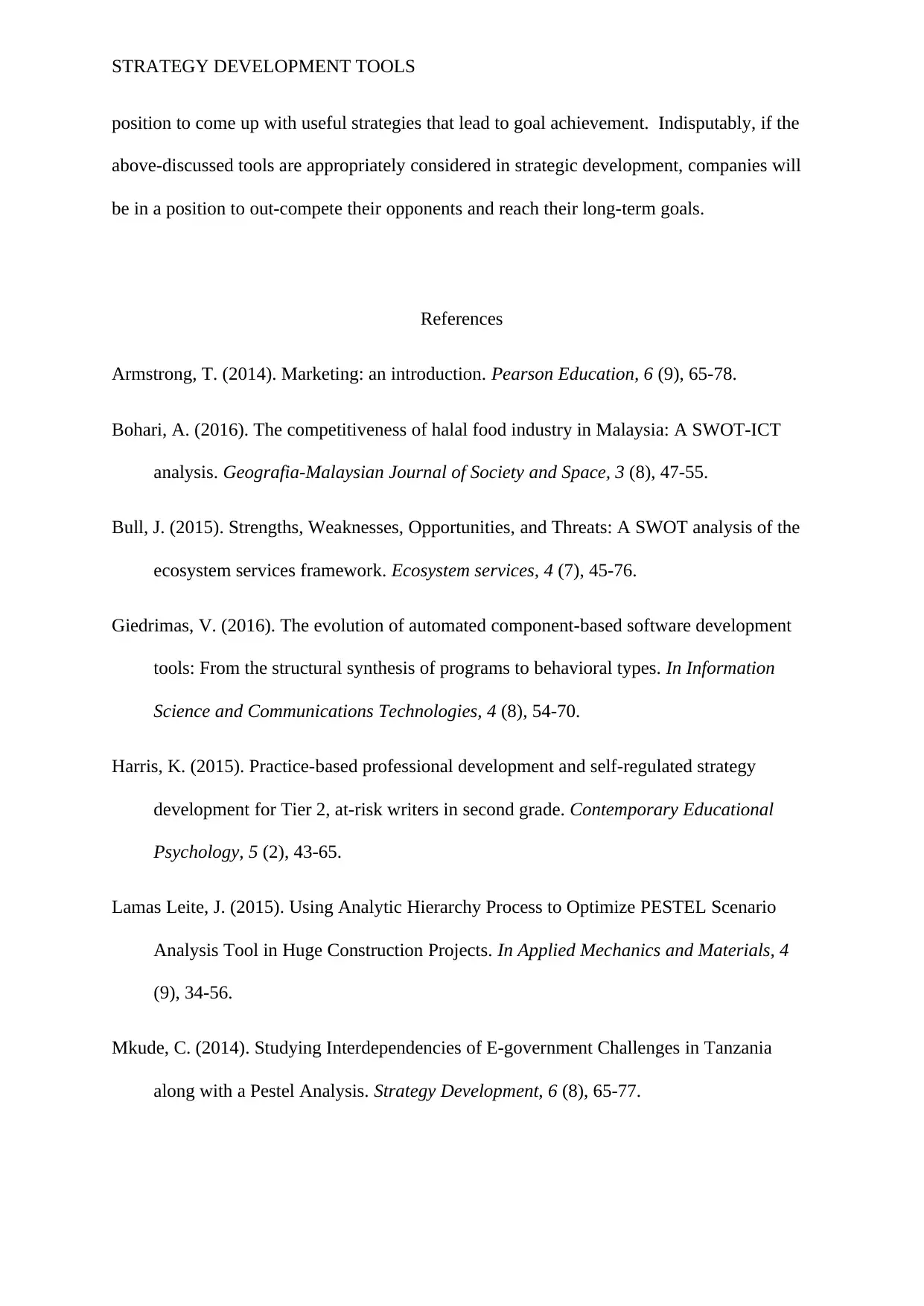
STRATEGY DEVELOPMENT TOOLS
position to come up with useful strategies that lead to goal achievement. Indisputably, if the
above-discussed tools are appropriately considered in strategic development, companies will
be in a position to out-compete their opponents and reach their long-term goals.
References
Armstrong, T. (2014). Marketing: an introduction. Pearson Education, 6 (9), 65-78.
Bohari, A. (2016). The competitiveness of halal food industry in Malaysia: A SWOT-ICT
analysis. Geografia-Malaysian Journal of Society and Space, 3 (8), 47-55.
Bull, J. (2015). Strengths, Weaknesses, Opportunities, and Threats: A SWOT analysis of the
ecosystem services framework. Ecosystem services, 4 (7), 45-76.
Giedrimas, V. (2016). The evolution of automated component-based software development
tools: From the structural synthesis of programs to behavioral types. In Information
Science and Communications Technologies, 4 (8), 54-70.
Harris, K. (2015). Practice-based professional development and self-regulated strategy
development for Tier 2, at-risk writers in second grade. Contemporary Educational
Psychology, 5 (2), 43-65.
Lamas Leite, J. (2015). Using Analytic Hierarchy Process to Optimize PESTEL Scenario
Analysis Tool in Huge Construction Projects. In Applied Mechanics and Materials, 4
(9), 34-56.
Mkude, C. (2014). Studying Interdependencies of E-government Challenges in Tanzania
along with a Pestel Analysis. Strategy Development, 6 (8), 65-77.
position to come up with useful strategies that lead to goal achievement. Indisputably, if the
above-discussed tools are appropriately considered in strategic development, companies will
be in a position to out-compete their opponents and reach their long-term goals.
References
Armstrong, T. (2014). Marketing: an introduction. Pearson Education, 6 (9), 65-78.
Bohari, A. (2016). The competitiveness of halal food industry in Malaysia: A SWOT-ICT
analysis. Geografia-Malaysian Journal of Society and Space, 3 (8), 47-55.
Bull, J. (2015). Strengths, Weaknesses, Opportunities, and Threats: A SWOT analysis of the
ecosystem services framework. Ecosystem services, 4 (7), 45-76.
Giedrimas, V. (2016). The evolution of automated component-based software development
tools: From the structural synthesis of programs to behavioral types. In Information
Science and Communications Technologies, 4 (8), 54-70.
Harris, K. (2015). Practice-based professional development and self-regulated strategy
development for Tier 2, at-risk writers in second grade. Contemporary Educational
Psychology, 5 (2), 43-65.
Lamas Leite, J. (2015). Using Analytic Hierarchy Process to Optimize PESTEL Scenario
Analysis Tool in Huge Construction Projects. In Applied Mechanics and Materials, 4
(9), 34-56.
Mkude, C. (2014). Studying Interdependencies of E-government Challenges in Tanzania
along with a Pestel Analysis. Strategy Development, 6 (8), 65-77.
⊘ This is a preview!⊘
Do you want full access?
Subscribe today to unlock all pages.

Trusted by 1+ million students worldwide
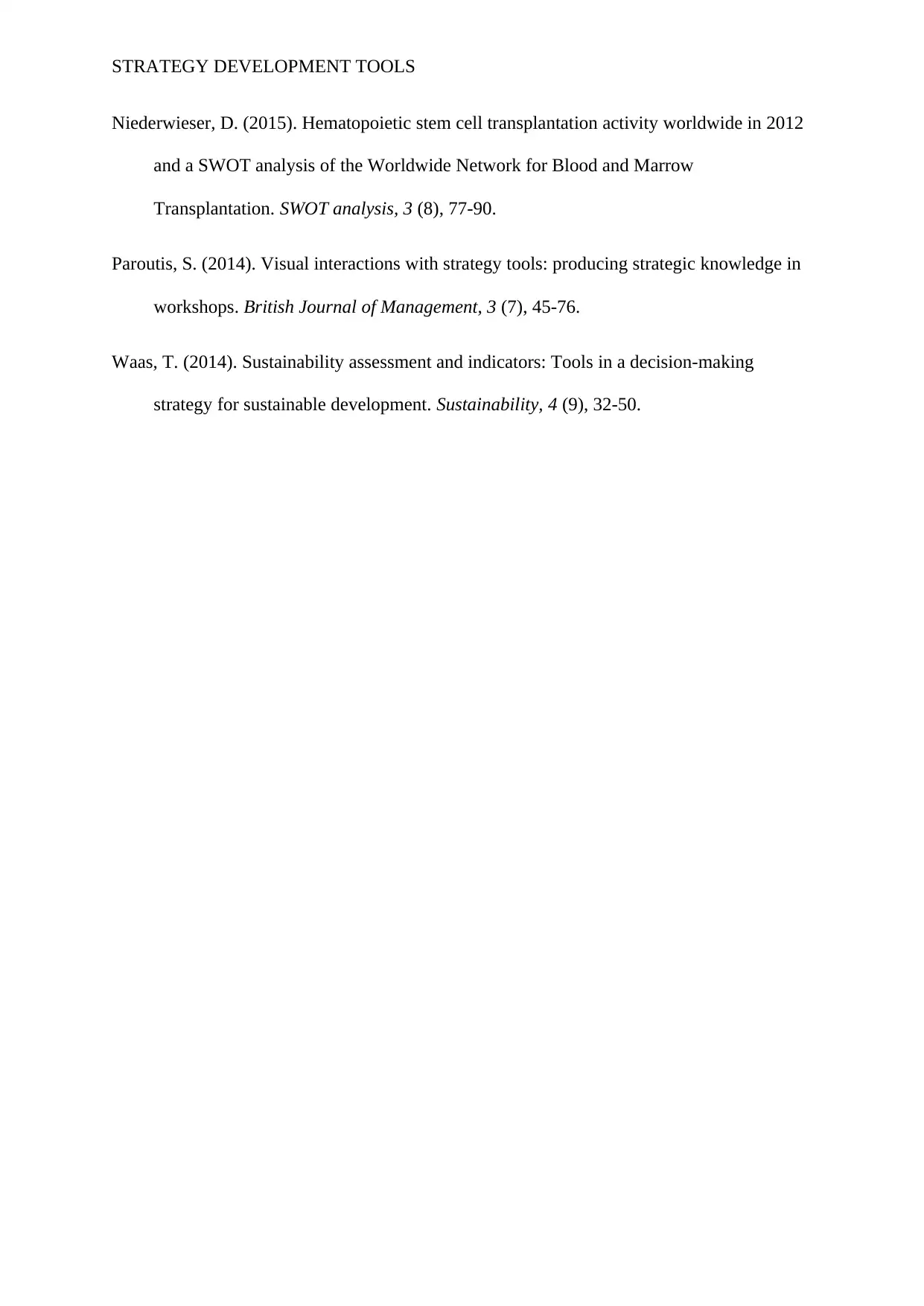
STRATEGY DEVELOPMENT TOOLS
Niederwieser, D. (2015). Hematopoietic stem cell transplantation activity worldwide in 2012
and a SWOT analysis of the Worldwide Network for Blood and Marrow
Transplantation. SWOT analysis, 3 (8), 77-90.
Paroutis, S. (2014). Visual interactions with strategy tools: producing strategic knowledge in
workshops. British Journal of Management, 3 (7), 45-76.
Waas, T. (2014). Sustainability assessment and indicators: Tools in a decision-making
strategy for sustainable development. Sustainability, 4 (9), 32-50.
Niederwieser, D. (2015). Hematopoietic stem cell transplantation activity worldwide in 2012
and a SWOT analysis of the Worldwide Network for Blood and Marrow
Transplantation. SWOT analysis, 3 (8), 77-90.
Paroutis, S. (2014). Visual interactions with strategy tools: producing strategic knowledge in
workshops. British Journal of Management, 3 (7), 45-76.
Waas, T. (2014). Sustainability assessment and indicators: Tools in a decision-making
strategy for sustainable development. Sustainability, 4 (9), 32-50.
1 out of 7
Related Documents
Your All-in-One AI-Powered Toolkit for Academic Success.
+13062052269
info@desklib.com
Available 24*7 on WhatsApp / Email
![[object Object]](/_next/static/media/star-bottom.7253800d.svg)
Unlock your academic potential
Copyright © 2020–2025 A2Z Services. All Rights Reserved. Developed and managed by ZUCOL.





